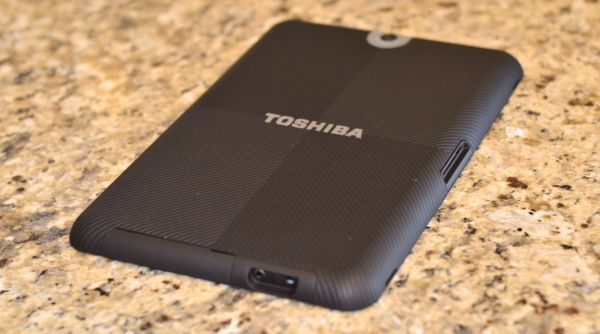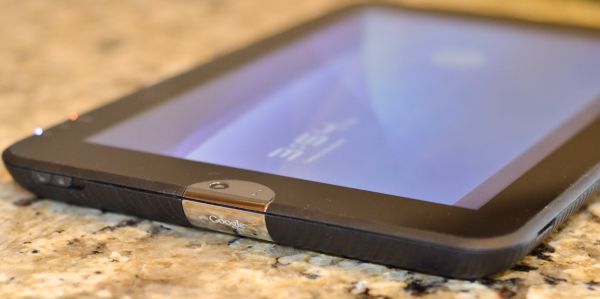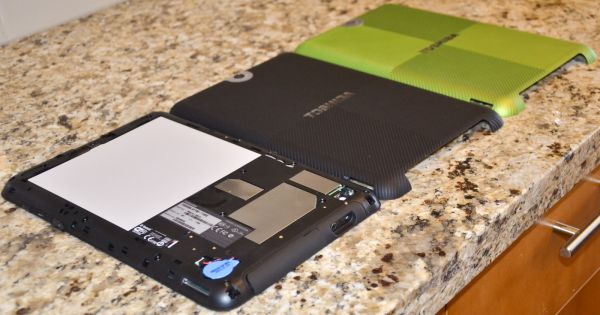Toshiba Thrive: Honeycomb Hits $300
by Vivek Gowri on December 12, 2011 3:00 AM ESTDesign-wise, the Thrive is a mixed bag. From the front, it looks pretty generic, save for a chrome webcam surround. The screen is obviously the dominant feature here, though the larger bezel leaves it with a larger footprint than the rest of the 10” tablets. Beyond that, the front of the tablet has the front facing camera, mic, light sensor, and notification LEDs for power, battery, and WiFi—pretty simple.
The back of the Thrive is more interesting; the battery cover takes up the entire rear portion, with a rubberized texture and chrome Toshiba badging. The curve of the sides and the texture make the Thrive feel pretty comfortable to hold, which is nice. The Thrive is a bit too wide to be ideal for one-handed use in landscape orientation, but for portrait and two-handed use, the design works well. The chrome webcam surround from the front wraps around to the back to house the rear facing camera as well.
It’s the single worst thing about the Thrive’s design—a distinctly cheap industrial design element on an otherwise clean, if somewhat generic, device. I’m not sure who at Toshiba decided this was a good idea, but evidently they liked it enough to push it to the 7” Thrive as well. The chrome plastic doesn’t help—if it was matte black plastic, or even a less-bright metal, I think I’d be a fan, just for adding an element of visual interest. But in chrome? It just looks kitschy.
The lid otherwise is pretty cool. It’s one of the few recent tablets with a removable battery, which is always nice. Toshiba offers a number of replacement lids in different colors—I got a bright green one from them; other options include silver, dark blue, lavender, and a magenta-type color that Toshiba calls Raspberry Fusion. It adds a nice touch of color to the otherwise completely black device, and the cost is surprisingly reasonable (I’ve seen them go on sale for $5-7 pretty regularly).
The best part of the design is the port selection. There are real, life-sized ports on board here—a USB port for connecting input devices and mass storage, a full-sized HDMI port (no smaller connectors or anything here, hooray!), a full-sized SD card slot, a mini-USB port to connect the tablet to a computer, and the standard headphone/mic combo jack.
All of these ports are hidden by a cover that basically is just a thin plastic contour that is attached to the tablet by a strip of flexible plastic that's begging to be fatigued into failure or simply torn off with an errant gesture. It holds itself to the tablet using small plastic clips, and has the unique distinction of being at once poorly built, annoying to use, and basically devoid of any functionality. If this were my personal unit, I would tear the cover off, it doesn't serve much purpose other than keeping dust out of the ports. That usually doesn't present itself as a problem on other mobile devices with exposed connectors, so I just don’t see the point.
Toshiba definitely made some missteps with the design and build here, but they show that they are learning. Their next tablet, the Excite, measures at exactly 7.7mm thick and 558g (basically one-upping the Galaxy Tab 10.1 and Transformer Prime), has none of the odd design elements that the Thrive does, and generally seems to bring Toshiba into the high-end of the Android tablet market. We’ll see about pricing and availability, but $499 and February wouldn’t be a bad bet. Either way, the Thrive isn’t nearly competitive with the Galaxy Tabs and iPads of the world from a device hardware standpoint. We expected that going in given the price delta, but it’s still worth noting that you do get what you pay for from a design standpoint.




















33 Comments
View All Comments
doggod - Monday, December 12, 2011 - link
How is what Microsoft wants, come into the net books argument at all. None of the tablets people are buying come with a Microsoft OS so you would imagine that manufactures would jump on having net books with android installed which negates any licensing costs.Personally I dont get their use either, apart as a toy. And an expensive toy.
Portability is negated by having to type on the screen( which if you haven't left the tablet down on a surface you have to do one handed)
Websites have to be zoomed to read properly
mathew7 - Tuesday, December 13, 2011 - link
"How is what Microsoft wants, come into the net books argument at all. None of the tablets people are buying come with a Microsoft OS so you would imagine that manufactures would jump on having net books with android installed which negates any licensing costs."Please research before you talk. Just a hint: tablets are not sold with Windows because there is no way to run it. The CPU from the tablets has nothing in common with what you have on a netbook or desktop. It's like diesel vs. gasoline engine: they both take you somewhere, but how they make power is completely different (you cannot run and/or you will damage either engine if you put the wrong fuel).
So tablet designers take no attention to MS Win Starter limitations. But netbook designers, even if the tablet will be sold with Win7 HP, it's still designed for Win7 Starter because of HW sharing between models.
DanNeely - Monday, December 12, 2011 - link
Viewing angles? IPS vs TN?Hrel - Monday, December 12, 2011 - link
I can't beleive someone who reads anandtech has to ask this. TN maxes out at about 170 degree viewing angles, marketed, not practical application. IPS is basically 180 degree, ie you can always see it and it always looks good. IPS has significantly longer response times though. Pretty much all flat panel LCD tv's are IPS.Aloonatic - Monday, December 12, 2011 - link
Why bother to read anandtech at all, when you know everything already?mjcutri - Monday, December 12, 2011 - link
I made the mistake of buying a Thrive for my wife when they first came out in July. It was one of my worst tech purchases ever. I liked the idea of the dock and full size ports, but the flaws just don't make up for what I perceived as advantages.The screen takes next to nothing to break it and Toshiba knows it. They charge over $300 to replace it. Initially you could get a replacement screen and spend 4 hours trying to fix it yourself, but there was such a run on them (since the screen is so crappy) that they ran out of stock quickly. Since then, they have increased the price from $80 to $160 for the replacement screen, which now isn't worth it.
I'm getting her a Transformer when the price drops on those.
mjcutri - Monday, December 12, 2011 - link
Oh yeah, I forgot to mention the incredibly buggy software.The well known problem of not waking from sleep has still not been fixed. (You have to turn it completely off and then back on again.) The screen randomly turn on by itself. (which is really annoying when you're trying to sleep.) The screen randomly doesn't go to sleep when you press the power button. (It just flashes black and then back on again.)
VivekGowri - Monday, December 12, 2011 - link
There was an update to fix the sleep-wake problem, I never encountered it after that...As for the screen, yeah - because it's plastic, it's easier to break/scratch/damage. I really, really wish Toshiba would have gone the extra distance and gone for Gorilla Glass or some other kind of chemically treated glass covering for the screen.mjcutri - Wednesday, December 21, 2011 - link
Yeah...that update...didn't fix crap...And the screen is glass, just not gorilla glass.
TexasAg03 - Monday, December 12, 2011 - link
"...eventually settling in the $4-500 range."Could you please let me know where the $4 tablets are?